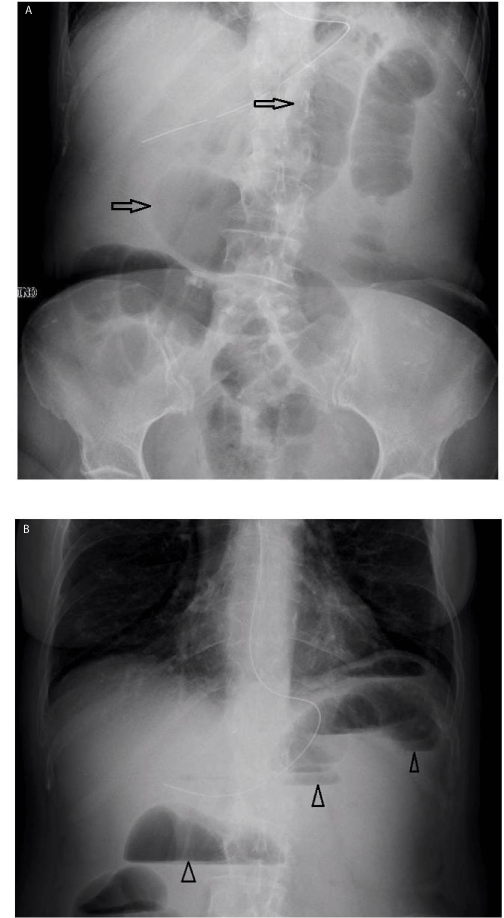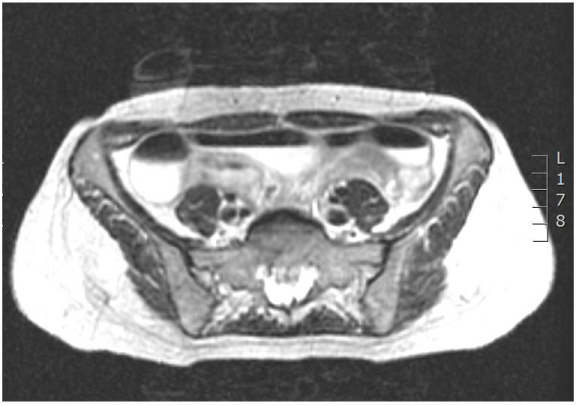
Case Report
Austin J Reprod Med Infertil. 2015; 2(6): 1030.
Is Endometriosis a Truly Benign Disorder? Report of a Case of Intestinal Endometriosis with Lymph Node Metastasis
De Nardi Paola*
Department of Gastrointestinal Surgery, San Raffaele Scientific Institute, Milan, Italy
*Corresponding author: De Nardi Paola, Department of Gastrointestinal Surgery, San Raffaele Scientific Institute, Via Olgettina 60, 20132 Milan, Italy
Received: August 24, 2015; Accepted: October 28, 2015; Published: October 30, 2015
Abstract
Endometriosis may affect the gastrointestinal tract in 3 to 37% of cases. However ileal involvement is rare accounting for 1-7% of all intestinal localizations. The case of a patient with an endometrial nodule on distal ileum wall, causing acute intestinal obstruction, who underwent right colectomy, is reported. The histology of the removed specimen also revealed the involvement of a regional lymph node. Several features of endometriosis raise questions about the benign nature of this disease.
Keywords: Deep infiltrating endometriosis; Intestinal endometriosis; lymph node endometriosis; Small bowel obstruction
Abbreviations
DIE: Deep Infiltrating Endometriosis
Case Presentation
A 43-year-old woman presented to our Emergency Department with cramping abdominal pain, nausea, vomiting and abdominal distension of 1 week duration. She complained milder but similar symptoms repeatedly over the past 6 months. She was nulliparous and her past medical history was marked by two spontaneous abortions. Laboratory tests showed elevated levels of white cells blood count (17.000/L), with no other abnormalities.
Abdominal plain X-ray (Figure 1) revealed markedly dilated ileal loops. Abdominal MRI (Figure 2) confirmed small bowel obstruction, but no clear cause could be detected. There was no evidence of enlarged lymph nodes.

Figure 1: X-ray plain abdominal film showing small bowel occlusion with
dilated small bowel loops (arrows) and air fluid levels (arrowheads).

Figure 2: Magnetic resonance imaging (axial T2-weighted sequence)
showing dilated small bowel loops without any noticeable obvious cause.
The patient underwent an emergency exploratory laparoscopy: a stricture in the terminal ileum was detected. Consequently, a right colectomy with ileocolic anastomosis was performed. Her postoperative course was uneventful and she was discharged on the 6th postoperative day. Histological examination showed a polypoid nodule of 2 cm located in the terminal ileum, 3 cm proximal to the ileocoecal junction, with normal mucosa and retraction of the serosa. Histologically the nodule showed endometriosis invading the serosa, the muscular and submucosa layers, with no mucosal infiltration; one of the removed loco-regional lymph nodes showed endometrial growth.
Discussion
Endometriosis is defined by the extrauterine presence of endometrial tissue. This painful condition affects up to 15% of women of childbearing age, and nearly half of all infertile women, while 70% of women with chronic pelvic pain eventually will be diagnosed as having endometriosis [1]. Three main manifestations of this disorder have been described, namely adenomyosis, peritoneal endometriosis, and deep infiltrating endometriosis (DIE). The latest is considered the most severe form of the disease. Endometriosis can involve extra genital organs, the most common site being the intestinal tract, although the omentum, the peritoneum and other intra-abdominal organs can also occasionally be involved. Intestinal endometriosis begins with implantation of endometrial cells on the serosa surface: theses lesions can progressively invade the muscularis propria and the submucosa layers, while the mucosa is rarely affected [2]; as suggested by Chapron the endometriotic lesions that do not infiltrate beyond the serosa that usually remains asymptomatic, should be considered peritoneal endometriosis [3]. The endometriotic nodules should at least reach the muscularis to be defined as true intestinal endometriosis; these lesions may cause fibrosis and thickening of the bowel wall, resulting in stricture and mechanical bowel obstruction. Although the recto sigmoid colon is the commonest site of involvement, any part of the gastrointestinal tract can be affected, as the coecum, the appendix and the small intestine that can be involved in 3%, 3.6%, and 7%, of cases respectively [4].
Endometriosis is generally considered as a benign disease. Actually endometriosis, and in particular DIE, shares several traits with malignancy. When we consider a malignant disease we refer to a disorder hallmarked by the tendency to get worse progressively, to involve and invade other organs and tissues, to give rise to metastasis, and to bear anaplasia. All these features can be found in DIE.
DIE is a progressive disease and, even if it does not cause catabolic disturbance, metabolic consequences, or death, it tends to get worse progressively [5]. The ability of DIE, to invade adjacent tissue extensively has been demonstrated, particularly for bowel endometriosis [6].
Endometrial cells are capable of dissemination and metastasis along the same channels followed by endometrial adenocarcinoma. Endometriotic implants have been found in several areas of the body even far from the pelvis or the abdominal cavity such as in lungs, pleura and skin [7].
Endometriotic glands may be transported by lymphatic channels with subsequent lymph node involvement. Lymph node involvement in endometriosis is usually considered to be uncommon. However some studies emphasize that this event might be underestimated. The presence of endometrial tissue has been documented in uterine draining pelvic lymph nodes but also in other lymph nodes draining the rest of the pelvis [8]. Noel found lymph node involvement in 42.3% of cases after recto sigmoid resection for endometriosis, with one to four lymph nodes affected in each specimen. Moreover the lymph node–positive status correlated significantly with the number of retrieved lymph nodes suggesting that a more radical surgical resection may reveal a higher rate of lymph node involvement [9]. Similar findings were reported by Abrao who found affected lymph nodes in 26.3% of patients after recto sigmoidectomy for endometriosis [10].
Lastly endometriosis demonstrates somatically acquired genetic alterations similar to those found in cancer, leading to clonal expansion of genetically abnormal cells [11,12].
The significance of such findings is still unknown and, even if require further investigation, they point out the systemic aspect of the disease.
Conclusion
Lymphatic spread of endometriosis, together with other features, underlines the potential malignant feature of this disease. Further studies are required to better clarify the pathogenesis and the behavior of endometriosis and therapeutic implications.
References
- De Nardi P, Ferrari F. Deep pelvic endometriosis: A multidisciplinary approach. Springer-Verlag. 2010.
- Anaf V, El Nakadi I, Simon P, Van de Stadt J, Fayt I, Simonart T, et al. Preferential infiltration of large bowel endometriosis along the nerves of the colon. Hum Reprod. 2004; 19: 996-1002.
- Chapron C, Fauconnier A, Vieira M, Barakat H, Dousset B, Pansini V, et al. Anatomical distribution of deeply infiltrating endometriosis: surgical implications and proposition for a classification Hum Reprod. 2003; 18: 157-161.
- Ferrero S, Camerini G, Maggiore ULR. Bowel endometriosis: Recent insights and unsolved problems. World J Gastrointest Surg. 2011; 3: 31-38.
- Koninckx PR, Meuleman C, Demeyere S, Lesaffre E, Cornillie FJ. Suggestive evidence that pelvic endometriosis is a progressive disease, whereas deeply infiltrating endometriosis is associated with pelvic pain. Fertil Steril. 1991; 55: 759-765.
- Thomas EJ, Campbell G. Evidence that endometriosis behaves in a malignant manner. Gynecol Obstet Invest. 2000; 50: 2–10.
- Bergqvist A. Different types of extragenital endometriosis: a review. Gynecol Endocrinol. 1993; 7: 207-221.
- Aoki M. Endometriosis of the pelvic lymph nodes. Pathol Int. 1967; 17: 217–234.
- Noël JC, Chapron C, Fayt I, Anaf V. Lymph node involvement and lymphovascular invasion in deep infiltrating rectosigmoid endometriosis. Fertil Steril. 2008; 89: 1069-1072.
- Abrao MS, Podgaec S, Dias JA, Averbach M, Garry R, Ferraz Silva LF, et al. Deeply infiltrating endometriosis affecting the rectum and lymph nodes. Fertil Steril. 2006; 86: 543–547.
- Fishman A, Demirel D, Laucirica R, Ramzy I, Klima T, Lyzak J, et al. Malignant tumors arising in endometriosis: clinical-pathological study and flow cytometry analysis. Eur J Obstet Gynecol Reprod Biol. 1996; 70: 69-74.
- Wu Y, Basir Z, Kajdacsy-Balla A, Strawn E, Macias V, Montgomery K, et al. Resolution of clonal origins for endometriotic lesions using laser capture microdissection and the human androgen receptor (HUMARA) assay. Fertil Steril. 2003; 79: 710-717.